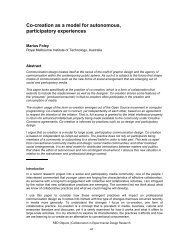Ceramic Tableware Recycling by Green Life 21 Project - Red Objects
Ceramic Tableware Recycling by Green Life 21 Project - Red Objects
Ceramic Tableware Recycling by Green Life 21 Project - Red Objects
Create successful ePaper yourself
Turn your PDF publications into a flip-book with our unique Google optimized e-Paper software.
7. Future Development<br />
<strong>Ceramic</strong> ware recycling activities began in 1997. To create a more sustainable ceramics industry<br />
and to promote manufacturing that improves environmental value, answers must be found for the<br />
following issues.<br />
7.1 Commercialization of High Combination Recycled <strong>Tableware</strong><br />
The combination ratio of recycled materials in recycled tableware was 20%; however, today, it is<br />
possible to produce recycled green body with a 50% combination ratio that can be used for<br />
manufacturing with the existing mass production technology. When compared with 20%<br />
combination ratio green body (hereinafter referred to as 20% body), the recycled material<br />
combination ratio is 2.5 times more than 20% body, the firing temperature is approximately 200<br />
degrees Celsius lower than for 20% body, and greenhouse gas emission from firing process can be<br />
reduced <strong>by</strong> a maximum of 33%. Therefore, the physicality of the 50% combination green body<br />
shows excellent environment efficiency (Tateishi et al. 2010). The bending strength is 1.5 times<br />
(120MPa) greater than 20% body. It is possible to improve product performance. In the future, our<br />
aim is not only to conduct recycling, but also to commercialize ceramic tableware that can be<br />
adopted <strong>by</strong> a lower carbon society.<br />
7.2 Commercialization of Used <strong>Tableware</strong><br />
In the section on the Network, we mentioned the significance of users promoting reuse before<br />
recycling the collected used tableware. This movement relates to the unique Japanese spirit of<br />
“Mottainai,” which means to cherish objects. The movement indicates that consumers require<br />
objects that are reusable even if they are used items. The author and other members conducted a<br />
survey and obtained the result that if disposable porcelain containers that are used for desserts,<br />
and other items were changed into types that are returnable five times, it would reduce greenhouse<br />
gas emissions during the entire product life-cycle to one-fifth of previous emissions because<br />
returning the container requires no energy (Hasegawa et al. 2008). The results suggest that the<br />
environmental impact would be smaller if the tableware had high usability and a long-life in usage.<br />
The spread of reuse activities among users will develop into repair and cleaning services using<br />
firing technology among manufacturers. It indicates a new direction in sustainable business for<br />
production areas.<br />
8. Conclusion<br />
<strong>Recycling</strong> activities for ceramic ware are also activities that involve many people through waste<br />
collection and separation and that cultivate communication among members of the community. A<br />
recent exhibition with the title “The Attraction of <strong>Tableware</strong> <strong>Recycling</strong>” was organized mainly <strong>by</strong><br />
citizens for an environment fair in Nagano Prefecture, Japan. The exhibition explained the attraction<br />
as the pleasure of engaging in activities that practice the spirit of “Mottainai” that is rooted in<br />
Japanese life and culture, and the development of communication among members of the<br />
community. In the past, in Japan, the traditional lifestyle saw people support each other in their daily<br />
lives through community festivals and seasonal events. In our modern world of weakened social<br />
ties, establishing relationships where people can come face to face with each other has now<br />
become a social issue. During the recovery from the great earthquake that struck Eastern Japan,<br />
human ties were once again recognized as a great basis for regenerating the area. Cultivating ties<br />
between people in the community through tableware recycling activities and improving community<br />
capabilities <strong>by</strong> means of these ties are also important roles of that tableware recycling in order to<br />
create a sustainable society.<br />
References<br />
Nobuaki MIYACHI, Yoshikazu HASEGAWA, 2009, ‘Approach to Construction of <strong>Recycling</strong> System<br />
for Porcelain’, CERAMICS JAPAN, vol.44, pp. 31-36.<br />
RED <strong>Objects</strong>⏐⏐Collaboration in Experimental Design Research<br />
81




